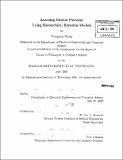| dc.contributor.advisor | W. Eric L. Grimson. | en_US |
| dc.contributor.author | Wang, Xiaogang, Ph. D. Massachusetts Institute of Technology | en_US |
| dc.contributor.other | Massachusetts Institute of Technology. Dept. of Electrical Engineering and Computer Science. | en_US |
| dc.date.accessioned | 2010-03-25T15:29:03Z | |
| dc.date.available | 2010-03-25T15:29:03Z | |
| dc.date.copyright | 2009 | en_US |
| dc.date.issued | 2009 | en_US |
| dc.identifier.uri | http://hdl.handle.net/1721.1/53306 | |
| dc.description | Thesis (Ph. D.)--Massachusetts Institute of Technology, Dept. of Electrical Engineering and Computer Science, 2009. | en_US |
| dc.description | Cataloged from PDF version of thesis. | en_US |
| dc.description | Includes bibliographical references (p. 163-179). | en_US |
| dc.description.abstract | In far-field visual surveillance, one of the key tasks is to monitor activities in the scene. Through learning motion patterns of objects, computers can help people understand typical activities, detect abnormal activities, and learn the models of semantically meaningful scene structures, such as paths commonly taken by objects. In medical imaging, some issues similar to learning motion patterns arise. Diffusion Tensor Magnetic Resonance Imaging (DT-MRI) is one of the first methods to visualize and quantify the organization of white matter in the brain in vivo. Using methods of tractography segmentation, one can connect local diffusion measurements to create global fiber trajectories, which can then be clustered into anatomically meaningful bundles. This is similar to clustering trajectories of objects in visual surveillance. In this thesis, we develop several unsupervised frameworks to learn motion patterns from complicated and large scale data sets using hierarchical Bayesian models. We explore their applications to activity analysis in far-field visual surveillance and tractography segmentation in medical imaging. Many existing activity analysis approaches in visual surveillance are ad hoc, relying on predefined rules or simple probabilistic models, which prohibits them from modeling complicated activities. Our hierarchical Bayesian models can structure dependency among a large number of variables to model complicated activities. Various constraints and knowledge can be nicely added into a Bayesian framework as priors. When the number of clusters is not well defined in advance, our nonparametric Bayesian models can learn it driven by data with Dirichlet Processes priors. | en_US |
| dc.description.abstract | (cont.) In this work, several hierarchical Bayesian models are proposed considering different types of scenes and different settings of cameras. If the scenes are crowded, it is difficult to track objects because of frequent occlusions and difficult to separate different types of co-occurring activities. We jointly model simple activities and complicated global behaviors at different hierarchical levels directly from moving pixels without tracking objects. If the scene is sparse and there is only a single camera view, we first track objects and then cluster trajectories into different activity categories. In the meanwhile, we learn the models of paths commonly taken by objects. Under the Bayesian framework, using the models of activities learned from historical data as priors, the models of activities can be dynamically updated over time. When multiple camera views are used to monitor a large area, by adding a smoothness constraint as a prior, our hierarchical Bayesian model clusters trajectories in multiple camera views without tracking objects across camera views. The topology of multiple camera views is assumed to be unknown and arbitrary. In tractography segmentation, our approach can cluster much larger scale data sets than existing approaches and automatically learn the number of bundles from data. We demonstrate the effectiveness of our approaches on multiple visual surveillance and medical imaging data sets. | en_US |
| dc.description.statementofresponsibility | by Xiaogang Wang. | en_US |
| dc.format.extent | 179 p. | en_US |
| dc.language.iso | eng | en_US |
| dc.publisher | Massachusetts Institute of Technology | en_US |
| dc.rights | M.I.T. theses are protected by
copyright. They may be viewed from this source for any purpose, but
reproduction or distribution in any format is prohibited without written
permission. See provided URL for inquiries about permission. | en_US |
| dc.rights.uri | http://dspace.mit.edu/handle/1721.1/7582 | en_US |
| dc.subject | Electrical Engineering and Computer Science. | en_US |
| dc.title | Learning motion patterns using hierarchical Bayesian models | en_US |
| dc.type | Thesis | en_US |
| dc.description.degree | Ph.D. | en_US |
| dc.contributor.department | Massachusetts Institute of Technology. Department of Electrical Engineering and Computer Science | |
| dc.identifier.oclc | 549381327 | en_US |
